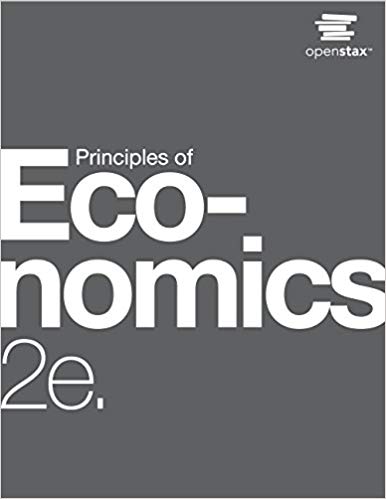
Classify the following as a government-enforced barrier to entry, a banker to entry that is not government-enforced, or a situation that does not involve a barrier to entry.
- A patented invention
- A popular but easily copied restaurant recipe
- An industry where economies of scale are very small compared to the size of
demand in the market - A well-established reputation for slashing prices in response to new entry
- A well-respected brand name that has been carefully built up over many years
(a)
The classification of the situation based on the given categories.
Answer to Problem 1SCQ
A patent invention is a government enforced barrier to entry.
Explanation of Solution
A patent is a legal assurance by the government which allows the patent holder an exclusive right to use the invention. It acts as barrier to entry as no one else other than the patent owner can reap the benefits of the invention unless the owner decides to sell it or lease it to another party.
Concept introduction:
Barrier to entry − The conditions or circumstances that prevent other firms from entering a particular industry are termed as barriers to entry. Such barriers can be either natural or government-enforced barriers.
Want to see more full solutions like this?
Chapter 9 Solutions
Principles of Economics 2e
Additional Business Textbook Solutions
Managerial Accounting (5th Edition)
Horngren's Accounting (11th Edition)
Managerial Accounting (4th Edition)
Construction Accounting And Financial Management (4th Edition)
Horngren's Cost Accounting: A Managerial Emphasis (16th Edition)
Principles of Accounting Volume 1
- Consider the local music scene in your area. Name some of the local live bands that play in clubs and music halls, both on and off-campus. Look in your local newspaper for advertisements for upcoming shows or performances. How would you characterize the market for local musicians? Is there product differentiation? In what specific ways do firms (individual performers or bands) compete? To what degree are they able to exercise market power? Are there barriers to entry? How profitable do you think the musicians are?arrow_forwardSupplier Set Price Versus Market-Determined Price: Collusion or Competition?arrow_forwardmonopolist's decision about how many unit to sell is realted to micro or macroeconomicsarrow_forward
- are more than just names and symbols. product quality packaging micromarketing product concept brands psychogrphic product demand segmented marketing behaviorarrow_forwardOrganizations use which pricing objective to maximize long-term sales? Breakeven pricing Profit maximization Markup pricing Profit-oriented pricing Market share maximizationarrow_forwardAdvertising and Integrated Marketing Communications. Identify messages that you have seen or heard from several companies. Are the companies being consistent with their messages across the markets they are targeting? What factors are causing the media landscape to change? How can you maximize the reach of the promotional mix on a limited budget (that is, how can you get the most exposure for a minimal investment)?arrow_forward
- policies government can have in place to increase perfect competition in the marketarrow_forwardWhether in the case of clothes and cars or in the case of universities, producers spend a lot of money establishing their "brand names" because: Group of answer choices Brand names are established by driving out the competition, after which these companies charge monopoly prices. Government legislation raises the prices of brand named items with price controls, and people have no choice but to pay the higher price for brand name products. There are legal requirements for companies with brand names to spend a percentage of their budget on advertising. Brand names carry a reputation of better quality, and consumers will pay a higher price for brand names.arrow_forwardCritically evaluate any two products (name of the product, specifications of theproduct, manufacturers details etc) of electronics goods or automobile goods and justify which brand product is the market leader in Oman and discuss what are the marketing strategiesrequired to make a good decision to be a market leader.arrow_forward
- Which of the following is not a barrier to entry? Group of answer choices high fixed costs ownership of a resource diseconomies of scale regulation and legal feesarrow_forwardAmazon company Describe anything that differentiates a product of your company, anything that generates barriers to entry and exit in your company, and any government policies that promote efficiency in your industry.arrow_forwardCrowdsourcing affects new product development by: Group of answer choices: A) providing a controlled, exciting environment for the development of new product ideas. B) being a secretive process that helps to firm collect new ideas that other firms haven't seen. C) providing the company with ideas from a great many sources, including consumers. D) allowing inventors of novel technical products a way to promote their ideas.arrow_forward
 Managerial Economics: A Problem Solving ApproachEconomicsISBN:9781337106665Author:Luke M. Froeb, Brian T. McCann, Michael R. Ward, Mike ShorPublisher:Cengage Learning
Managerial Economics: A Problem Solving ApproachEconomicsISBN:9781337106665Author:Luke M. Froeb, Brian T. McCann, Michael R. Ward, Mike ShorPublisher:Cengage Learning Economics Today and Tomorrow, Student EditionEconomicsISBN:9780078747663Author:McGraw-HillPublisher:Glencoe/McGraw-Hill School Pub Co
Economics Today and Tomorrow, Student EditionEconomicsISBN:9780078747663Author:McGraw-HillPublisher:Glencoe/McGraw-Hill School Pub Co Managerial Economics: Applications, Strategies an...EconomicsISBN:9781305506381Author:James R. McGuigan, R. Charles Moyer, Frederick H.deB. HarrisPublisher:Cengage Learning
Managerial Economics: Applications, Strategies an...EconomicsISBN:9781305506381Author:James R. McGuigan, R. Charles Moyer, Frederick H.deB. HarrisPublisher:Cengage Learning







